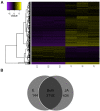The Pokeweed Leaf mRNA Transcriptome and Its Regulation by Jasmonic Acid
- PMID: 27014307
- PMCID: PMC4792876
- DOI: 10.3389/fpls.2016.00283
The Pokeweed Leaf mRNA Transcriptome and Its Regulation by Jasmonic Acid
Abstract
The American pokeweed plant, Phytolacca americana, is recognized for synthesizing pokeweed antiviral protein (PAP), a ribosome inactivating protein (RIP) that inhibits the replication of several plant and animal viruses. The plant is also a heavy metal accumulator with applications in soil remediation. However, little is known about pokeweed stress responses, as large-scale sequencing projects have not been performed for this species. Here, we sequenced the mRNA transcriptome of pokeweed in the presence and absence of jasmonic acid (JA), a hormone mediating plant defense. Trinity-based de novo assembly of mRNA from leaf tissue and BLASTx homology searches against public sequence databases resulted in the annotation of 59 096 transcripts. Differential expression analysis identified JA-responsive genes that may be involved in defense against pathogen infection and herbivory. We confirmed the existence of several PAP isoforms and cloned a potentially novel isoform of PAP. Expression analysis indicated that PAP isoforms are differentially responsive to JA, perhaps indicating specialized roles within the plant. Finally, we identified 52 305 natural antisense transcript pairs, four of which comprised PAP isoforms, suggesting a novel form of RIP gene regulation. This transcriptome-wide study of a Phytolaccaceae family member provides a source of new genes that may be involved in stress tolerance in this plant. The sequences generated in our study have been deposited in the SRA database under project # SRP069141.
Keywords: Phytolacca americana; RNA-seq; jasmonic acid; natural antisense transcript; pokeweed; pokeweed antiviral protein; ribosome inactivating protein; transcriptome.
Figures





Similar articles
-
Integration of the Pokeweed miRNA and mRNA Transcriptomes Reveals Targeting of Jasmonic Acid-Responsive Genes.Front Plant Sci. 2018 May 3;9:589. doi: 10.3389/fpls.2018.00589. eCollection 2018. Front Plant Sci. 2018. PMID: 29774043 Free PMC article.
-
Improved pokeweed genome assembly and early gene expression changes in response to jasmonic acid.BMC Plant Biol. 2024 Aug 24;24(1):801. doi: 10.1186/s12870-024-05446-1. BMC Plant Biol. 2024. PMID: 39179987 Free PMC article.
-
De novo Assembly of the Pokeweed Genome Provides Insight Into Pokeweed Antiviral Protein (PAP) Gene Expression.Front Plant Sci. 2019 Aug 6;10:1002. doi: 10.3389/fpls.2019.01002. eCollection 2019. Front Plant Sci. 2019. PMID: 31447869 Free PMC article.
-
A small RNA targets pokeweed antiviral protein transcript.Physiol Plant. 2016 Mar;156(3):241-51. doi: 10.1111/ppl.12393. Epub 2015 Nov 16. Physiol Plant. 2016. PMID: 26449874
-
Pokeweed antiviral protein: its cytotoxicity mechanism and applications in plant disease resistance.Toxins (Basel). 2015 Mar 6;7(3):755-72. doi: 10.3390/toxins7030755. Toxins (Basel). 2015. PMID: 25756953 Free PMC article. Review.
Cited by
-
Prediction and Characterization of miRNA/Target Pairs in Non-Model Plants Using RNA-seq.Curr Protoc Plant Biol. 2019 Jun;4(2):e20090. doi: 10.1002/cppb.20090. Epub 2019 May 13. Curr Protoc Plant Biol. 2019. PMID: 31083771 Free PMC article.
-
Comparative transcriptome analysis of the hyperaccumulator plant Phytolacca americana in response to cadmium stress.3 Biotech. 2021 Jul;11(7):327. doi: 10.1007/s13205-021-02865-x. Epub 2021 Jun 12. 3 Biotech. 2021. PMID: 34194911 Free PMC article.
-
Full-length transcriptome analysis of Phytolacca americana and its congener P. icosandra and gene expression normalization in three Phytolaccaceae species.BMC Plant Biol. 2020 Aug 27;20(1):396. doi: 10.1186/s12870-020-02608-9. BMC Plant Biol. 2020. PMID: 32854620 Free PMC article.
-
Integration of the Pokeweed miRNA and mRNA Transcriptomes Reveals Targeting of Jasmonic Acid-Responsive Genes.Front Plant Sci. 2018 May 3;9:589. doi: 10.3389/fpls.2018.00589. eCollection 2018. Front Plant Sci. 2018. PMID: 29774043 Free PMC article.
-
Improved pokeweed genome assembly and early gene expression changes in response to jasmonic acid.BMC Plant Biol. 2024 Aug 24;24(1):801. doi: 10.1186/s12870-024-05446-1. BMC Plant Biol. 2024. PMID: 39179987 Free PMC article.
References
-
- Ayashi T. H., Obayashi D. K., Ariu T. K., Ahara M. T., Ada K. H., Ouzuma Y. K., et al. (2003). Genomic cloning of ribonucleases in Nicotiana glutinosa leaves, as induced in response to wounding or to TMV-infection, and characterization of their promoters. Biosci. Biotechnol. Biochem. 67 2574–2583. 10.1271/bbb.67.2574 - DOI - PubMed
LinkOut - more resources
Full Text Sources
Other Literature Sources
Research Materials
Miscellaneous

